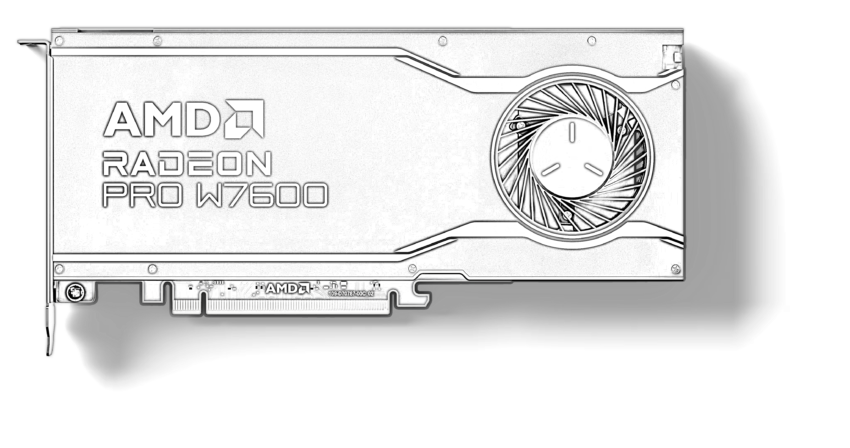Introduction:
AMD expands its Radeon Pro workstation graphics card lineup with the introduction of the Radeon Pro W7600 and Radeon Pro W7500, delivering the latest RDNA 3 architecture and professional-focused features to mainstream creators and professionals. The new cards aim to provide excellent price-to-performance ratios, making high-end workstation graphics more accessible to a broader range of users.
With 8GB memory, AV1 encoding, DisplayPort 2.1, and dedicated AI acceleration, the cards can efficiently tackle CAD, animation, rendering, video editing and other demanding workflows. The W7600 and W7500 cards start at $599 and $429 respectively, and are now available from retailers, with OEM and system integrator models coming later this year. With the new releases, AMD is enabling more professionals to take advantage of cutting-edge graphics power and capabilities for enhanced productivity and creativity.
Comparison to Competitors:
The Radeon Pro W7600 is built on AMD’s latest RDNA 3 architecture, which brings improvements to compute units, raytracing, and AI acceleration compared to the previous RDNA 2 architecture. Specifically, it has 96 compute units and ray accelerators, delivering up to 18.5 TFLOPS of single precision compute performance. This represents a significant uplift over the prior W6600 card based on RDNA 2, which had only 32 compute units and 10 TFLOPS performance.
Compared to NVIDIA’s Quadro RTX 4000 card that is also aimed at mainstream professional workflows, the W7600 should have a performance edge thanks to the advanced RDNA 3 architecture. The Quadro RTX 4000 is built on NVIDIA’s Turing architecture and has 2560 CUDA cores, delivering up to 7.1 TFLOPS FP32 performance.
The Radeon Pro W7500 also utilizes RDNA 3 and has 28 compute units and ray accelerators, capable of up to 8.8 TFLOPS performance. This slots it above NVIDIA’s Quadro T1000 with its Turing TU117 GPU and 1024 CUDA cores (4.1 TFLOPS).
Both new AMD cards have 8GB of GDDR6 memory on a 128-bit bus. The RTX 4000 has 12GB GDDR6 with 192-bit bus, so AMD is trading some memory capacity for the advanced RDNA 3 architecture.
The W7600 and W7500 look very competitive in terms of price and performance. AMD is bringing RDNA 3 advantages like AI acceleration, raytracing improvements, and advanced media encoding to more mainstream professional users. This could make them popular options for running professional workflows with tight budgets.
| Card | Architecture | GPU | Compute Units | TFLOPS | Memory | Memory Bus | Price |
| Radeon Pro W7600 | RDNA 3 | Navi 31 | 96 | 18.5 TFLOPS | 8GB GDDR6 | 128-bit | $599 |
| Radeon Pro W7500 | RDNA 3 | Navi 31 | 28 | 8.8 TFLOPS | 8GB GDDR6 | 128-bit | $429 |
| Quadro RTX 4000 | Turing | TU106 | 2560 CUDA cores | 7.1 TFLOPS | 12GB GDDR6 | 192-bit | $900 |
| Quadro T1000 | Turing | TU117 | 1024 CUDA cores | 4.1 TFLOPS | 4GB GDDR6 | 128-bit | $400 |
- AMD announced two new AMD Radeon PRO workstation graphics cards: the Radeon PRO W7600 and Radeon PRO W7500.
- The cards are aimed at mainstream professional workloads like media, design, engineering, and architecture.
- They leverage the new AMD RDNA 3 architecture for improved performance and efficiency. Key features include dedicated AI acceleration, 8GB GDDR6 memory, DisplayPort 2.1, and AV1 encode/decode.
- The cards offer great price/performance ratio and stability for professionals.
- The W7600 has a starting price of $599, while the W7500 starts at $429.
- The cards will be available starting today from retailers. OEM and system integrator availability is expected later this year.
- AMD is showcasing the cards at SIGGRAPH 2023 from August 8-10.
AMD continues to push the envelope of graphics innovation with the Radeon Pro W7000 series. These new cards demonstrate AMD’s commitment to providing cutting-edge yet accessible solutions for professional users.
“Working across multiple displays in SOLIDWORKS® while also prepping for 3D printing is flawless,” said Dr. Adi Pandzic, PhD, mechanical engineer. “The new 7000 series Radeon PRO cards allow me to multi-task across all my key apps with ease.”
With competitive pricing, robust professional drivers and application certification, AMD aims to make high-performance workstation graphics more attainable. This allows professionals across industries to take advantage of the latest technology to drive productivity and creativity.
AMD has a strong roadmap focused on the professional graphics segment. The company plans to continue introducing new Radeon Pro offerings that leverage innovations like RDNA 3 across a range of performance levels. AMD’s goal is to provide professionals the graphics horsepower they need to bring their visions to life.
Whether it’s creating lifelike 3D scenes, editing 8K video footage, working with massive CAD and BIM datasets, or training advanced AI models, the Radeon Pro W7600 and W7500 graphics cards empower professionals with AMD’s cutting-edge technology. AMD looks forward to seeing the future creations enabled by these new cards in the hands of designers, engineers, animators and other creators around the world.
Copyright 2023 AMD. All rights reserved. Information contained herein is for informational purposes only. AMD makes no representations or warranties with respect to the accuracy or completeness of the contents of this publication and reserves the right to make changes to specifications and product descriptions at any time without notice. AMD, the AMD Arrow logo, Radeon, RDNA, and combinations thereof are trademarks of Advanced Micro Devices, Inc. Other product names used in this publication are for identification purposes only and may be trademarks of their respective companies.

